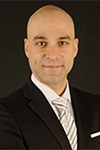Disruption: HR for Challenging Times
By Nancy Painter
Change surrounds us. The world has changed in every conceivable—and previously inconceivable—way within a generation.
Some changes we take in stride: the weather has changed since last week, our colleague is in a better mood today than yesterday, a faster, better, iSomething has just launched.
The question is though, when does change in the wider world become disruption in the workplace, and how does that affect an organization’s expectations of human resources?
 “Life overall is disruptive,” says Su Townsend, market leader for Optimum Talent. “Every single day there are things that are potentially disruptive. We’re more aware of things than people used to be; there’s the instant availability of information. The norm is constant disruption.”
“Life overall is disruptive,” says Su Townsend, market leader for Optimum Talent. “Every single day there are things that are potentially disruptive. We’re more aware of things than people used to be; there’s the instant availability of information. The norm is constant disruption.”
While disruption can stem from changes in technology, employee expectations, market forces and more, there are some common approaches HR can take to not only handle it, but to use it to strengthen their organization and their own role within it.
Redesigning the Employee Experience
 “The challenge today is that employees want to work, and leaders want to lead, but they get confused by all the technology we have,” says Benoit Hardy-Vallee, executive advisor to IBM Smarter Workforce and Social Business.
“The challenge today is that employees want to work, and leaders want to lead, but they get confused by all the technology we have,” says Benoit Hardy-Vallee, executive advisor to IBM Smarter Workforce and Social Business.
In Hardy-Vallee’s eyes, HR must zoom out and look at the employee experience, which is larger than employee engagement he says; we should consider HR to be an experience designer.
“Look at the technology you have, how it is evolving, and what employees are experiencing— their interactions with others and how many emails they get per day, for example. These are all moments of truth,” Hardy-Vallee says. “To be really agile, we must use design syncing. Start out with the user experience instead of just adding a new program. Map out the different steps and what employees need to make the experience meaningful and productive.”
As artificial intelligence and cognitive systems become more commonplace, he explains “the experience of the employee will be largely transformed. They will start interacting with systems in natural language. An employee with a question about benefits will be chatting with a chatbot.”
Freeing HR To Do What It Does Best
Hardy-Vallee notes that while the employee experience is impacted by IT, Communications and Marketing, it is HR which has to own both the experience and its employer brand, while collaborating closely with Marketing so the brand resonates consistently in both the marketplace and the workplace.
HR’s core expertise is people knowledge, he explains. Humans are good at conceptual understanding, empathy, and making joint decisions; computers are more productive at crunching data.
With the tools doing the heavy lifting, HR can concentrate on strategic direction and advice. Once cognitive systems are in place, HR can become an internal professional service to advise on talent recruitment and planning, Hardy-Vallee says.
Cognitive Systems Aid Collaboration
“Companies that are able to survive disruption, and flourish, are much more likely to use cognitive capabilities,” he adds. The top five per cent or ‘torch bearers’ optimize processes, know how to use technology, and use it to improve how they collaborate.
For example, direct and easy access to a chatbot will free an employee from the often time-consuming task of setting up meetings. The chatbot can also point workers toward the most important task they have to complete that day.
The idea of better enabling collaboration is key moving forward, Hardy-Vallee adds. Currently, collaboration is often ad hoc—people choose teammates on the basis of who they’ve worked with before or other personal reasons. There is no rigour in the selection method, whereas using technology enables employees to be paired or teamed up in more productive ways.
“We used to say that HR used people skills, then we went to using hard skills. If we look at the evolution of HR with technology, our skills must be fluid skills,” he concludes. “We need to ask the right questions and feed what we learn back to the business. Then we will be true HR leaders. HR should not just advise, but come up with its own decisions, backed by the evidence, data and method that technology can provide.”
Despite Challenge, Technology Key to Deeper Insights
 Brenda Rigney, CHRP, VP of people operations for Nurse Next Door Home Care Services, realizes technology can be a major disruption—either in its introduction, or in its antiquation, when programs that once served well become cumbersome, and unable to serve different business requirements such as globalization.
Brenda Rigney, CHRP, VP of people operations for Nurse Next Door Home Care Services, realizes technology can be a major disruption—either in its introduction, or in its antiquation, when programs that once served well become cumbersome, and unable to serve different business requirements such as globalization.
Rigney notes that smaller HR teams in particular, may not yet have the resources to buy or update their systems. However, the analytics made possible by technology are what will enable HR to provide CEOs with deeper insight into the workforce, to spot trends and provide predictive analytics.
“Analytics can guide office development,” Rigney says. “You have to grow where the talent is, not expect it to come to you.” If most of the engineers in an industry are in one location, a business will have to establish an office there instead of expecting employees to move to an existing location.
Empowering a Multi-faceted HR
To fulfill its role, HR needs to build teams with expertise in IT, social media, marketing campaigns and specialized writing styles. “You need a clear line with IT to set up the reporting tools,” Rigney explains. “You can continue to knock on Marketing and IT’s doors, or you can bring that expertise into your own department.”
“If HR isn’t getting into the game fast enough, other departments will take over their work,” she warns. “The department lines are getting blurred because HR is not stepping up, into 2020 and beyond.”
HR must learn, and be able to teach, how to manage from afar and develop great relationships with people who aren’t in the same physical office, including developing leadership.
To achieve this, HR will have to be comfortable with collaborative technology. Rigney advises HR leaders to “work one week with your software developer, see how they work from different locations and the flexibility they bring to their work.”
Flexibility in the Multi-Generational Workplace
Unlike some, she doesn’t see differing expectations from younger generations in the workplace as disruptive—and understands how technology answers at least some of those needs.
“Any new generation has different expectations than their parents’ group had and wants to change things up. Our generation wanted feedback, and the chance to grow and move up. Younger employees expect more from their employer, and are very deliberate about it,” says Rigney.
The notable difference with younger employees, Rigney says, is that HR isn’t competing with other employers. Instead, the employees will use their skills to set up their own consultancy if they don’t experience growth and feel they’re making an impact in the organization. With current technology, many of them can work out of a coffee shop or while they’re on vacation.
“HR needs to get out of its comfort zone,” she says. “We need to think differently about everything we’ve been doing up to now.”
She points to Nurse Next Door, which began in Vancouver 12 years ago, now has franchises across North America, and plans to establish itself as a global operation in four continents over the next three years. It’s an ideal example of a non-traditional workplace.
“It influences how we think, work, lead, connect with our people who don’t have supervisors around them every day, who work in clients’ homes and have entrepreneurial spirit,” Rigney says. “It requires a huge amount of trust, as they are representing our brand and our care standards in the world.”
In challenging times, she finds herself right at home. Rigney is accustomed to working in start-ups or organizations undergoing massive growth. “I’m a bit of a disrupter; I like to come into disruption,” she admits.
She identifies success as getting cross-functional team members to work together holistically, so they have one focus, one leadership, and can create bold strategy together.
Building a Resilient Workforce
While technology provides greater insight into employees as groups, how to handle disruption is still a very human affair, and how we humans, HR in particular, handle it, will determine how the organization fares.
According to Townsend, the key to handling disruption well is resilience. She’s familiar with workplace disruption, having recently experienced a merger/buy-out, as well as a few significant downsizings during her career.
“The problem is that some people aren’t resilient or have lost their resilience,” Townsend explains, adding that HR should pull people together to go with the change instead of fighting it. “We need to communicate change so that people retain as much resilience as they can.The harsher we are with people who have no resilience, the more we take everything away from them.”
“You need to have people with a lot of empathy at the senior levels; if they don’t, they won’t understand how the disruption will be for others. Then HR has an enormous job helping the employees,” she says.
Anyone who announces a major disruption, and then tells employees things will be business as usual, should give their head a shake, Townsend adds. The utter impossibility of that happening will only make people angry.
Working the Resilience Muscle
As for antidotes for disruption, resilience has proven effective, as evidenced by people who live balanced lives. “They will subconsciously decide to do things to increase their resilience, to grow and develop themselves. It’s a sign of resiliency to expand your horizons, to grow, adapt and change,” says Townsend.
Balancing such efforts is an awareness that they can’t work themselves so hard that they destroy their resilience. “Resilient people believe in downtime, and developing their own consciousness and awareness,” she says.
Resilience can be learned, but as with any muscle, it must be exercised to be ready when needed. ”And in order to provide that advice to others, we need to be doing it ourselves as well,” Townsend points out. “We often stretch ourselves too far. We care about other people, but that empathy takes something out of us. We have to pay attention to our own confidence, strength and resilience—and not stretch it so far that we can break. When you are the last person you think about, it’s quite hard to change that order. HR needs to be aware of that in teams and individuals.”
Townsend compares it to the warning in aircraft safety recitations—put on your own oxygen mask before helping others, or you won’t be able to help them.
Some HR practitioners use personal coaches to help them develop resiliency skills. Townsend tries to constantly challenge herself so that she doesn’t get too comfortable, and to be of service to others. In her case, she volunteers in a restorative justice program, as well as working with people who are considering suicide. “In giving to others, you learn in the process.”
Creating Confidence in Employees
“I don’t think we really understand that confidence is a fragile thing,” Townsend says. “A sense of security is also very fragile these days.”
An organization that values its employees at all times is building their confidence, which will equip them with resilience to better handle change down the road.
Finding meaning in their work is as important to employees as productivity, Hardy-Vallee says. “We all want to know that our company stands for something and that we belong to something bigger than ourselves.”
Rigney sees more and more companies paying attention to those less tangible employee needs. “It’s about intention, purpose, conscious populism, relationships, thinking environmentally—it plays into what employees are looking for.”
At Nurse Next Door, she explains, “We help our clients age more happily, but we also look at how do the 20-, 30-, 40-year-olds working for us live the happiest, most healthy lives they can.”
As a result, all employees and franchise partners are eligible for the Dreams program—wherein they are encouraged to share personal dreams with their superiors, and the company grants some of them.
“Our director of marketing wanted to take his Dad to see the Green Bay Packers play in Florida. We were able to pay for their travel, their stay, their tickets, and through some contacts get them right down close to the players,” says Rigney.
There wasn’t a dry eye in their call centre on Christmas Day, she adds, when they told Queenie, one of the team leads, that the company was granting her wish to bring her family from China to see where she was building her new life. Five members of her family will come to Canada this August.
“That’s what we want to be about,” Rigney says. Aside from the personal satisfaction such a program provides, it also builds a belief among employees of their value, which fosters confidence and benefits a resiliency they can draw on when and as needed.
Changing How We Think
Interestingly, while such belief building is not rocket science, it is most certainly underpinned by a great deal of emerging brain science, which brings us back to where the greatest disruptions impact—in our minds. Owning disruption at the individual level is the key to any aspirations of organizational change in the minds of many.

The mere scope of all the changes can be a disruption in the workplace, according to Matt Summers, a specialist in neuroscience social research, and practical workplace applications of research findings.
As the manager of Education Administration, Leadership Development at Vancouver Coastal Health Authority, a director of The Cognitive Learner, and an associate professor at the Beedie Business School at Simon Fraser University, his focus is very much on our minds at work.
The most disruptive force in the workplace, he believes, is how people’s brains get hijacked by day-to-day activities such as email, decision-making processes and rewards, social disruptions and technology.
“From a brain-based perspective, this is counterproductive; it engages parts of our brain that relate to our threat or reward response systems,” Summers says. “When this part of our brain is activated, we limit our ability to engage the logical and analytical part of our brain.”
Nonetheless, most people start their day by checking email; many have already checked it on their phone at home or en route to work. Our culture encourages an expectation that emails will be responded to as soon as possible.
A Tale of Two Thinking Processes
Recent neuroscience research shows that our brains while are wired to conserve energy, we can expend much of it on the large number of decisions we make every day.
Our brains have developed two thinking processes, Summers explains. “Our primary system, or System One thinking, is our automatic and unconscious thinking process. Most of our thinking occurs here as a way of speeding up decision-making, thereby conserving cognitive energy.”
The secondary system, or System Two thinking, is our critical and analytical thinking process. However, people most often make decisions from their primary thinking system, and seldom fully engage their secondary critical thinking system.
Summers quotes his colleague, Dr. Josh Davis, who says that each person experiences a decision point in their thinking process. When they are disrupted by pop-up email notifications or someone stepping into their office unexpectedly, their unconscious minds take over and decide for them how to respond to the distractions.
“But we can intentionally plan for future interruptions by looking for this decision point and, within it, consciously choose a change in our normal response or behaviour,” Summers says.
“You know that your day will always have emails or unexpected conversations in it. A predictable response to these could be to imbed into your thinking a certain action or response to that distraction—such as respectfully asking the other person to engage later or ignoring the pop-up emails. Even better, consciously choose to turn off the pop-up email notifications,” he explains. “I believe that this will dramatically change our levels of productivity and our ability to think more strategically, with deepened focus.”
Three Steps to Conserve Brain Energy
The brain has limited mental energy; distractions can consume vital resources that could be utilized in more impactful work. “In my consulting work, I see numerous organizations suffer from this common practice of misspent mental energy, resulting in poor decision-making and rushed implementation of inaccurate business solutions,” Summers says.
He offers three steps to mitigate distractions and conserve brain energy:
- Acknowledge and accept that your brain systems have given you unconscious biased thinking that influences everyday decision-making.
- Take responsibility for how you handle regular distractions. Put a sign on your office door that says, “Busy—please do not interrupt.” Book a regular 45-minute slot in your day to devote to more critical and mindful thinking. Discuss expectations with your colleagues so they know you won’t answer their emails immediately. Turn off pop-up notifications.
- Go beyond prioritizing your work to identify which items on your to-do list need more System Two critical thinking. Make sure you tackle them when your brain has its greatest amount of mental energy. Discern which time of day you have the most cognitive energy, and try to schedule analytical or critical thinking or creative decision-making at that time.
Developing mitigating tactics to counteract the brain’s unconscious bias to conserve energy will enable individuals to overcome it. For example, Summers says, if you recognize that your bias causes you to always want to make decisions quickly, force yourself to generate a list of alternative ideas or solutions, and have a trusted peer review them.
“We can’t ignore what the science is telling us,” he adds. “HR leaders must think differently and demonstrate it—they have to model it,” before supporting leaders and staff to engage in System Two thinking.
“By slowing down our thinking, generating options and engaging in conversations with others, we activate our analytical pre-frontal cortex and often are able to generate more thoughtful solutions or activate more creative ideas for consideration,” says Summers.
“If we can master the way we make decisions in our minds, we can master change.”
Nancy Painter is a freelance business writer and a member of the International Association of Business Communicators.
(PeopleTalk Spring 2016)









